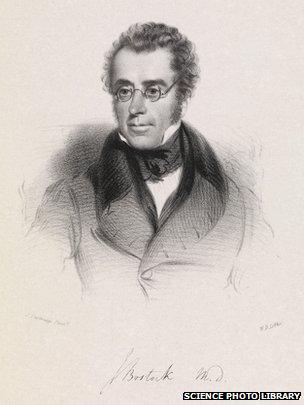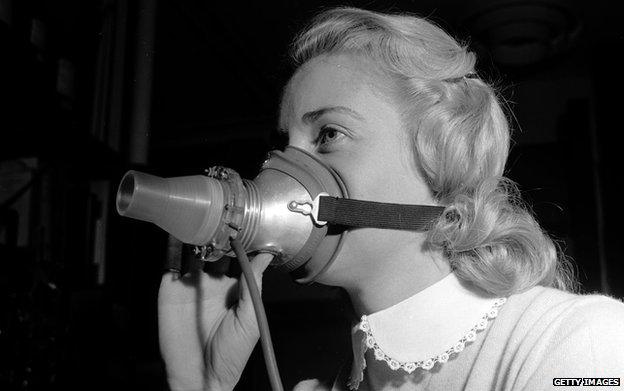John Bostock: The man who 'discovered' hay fever
- Published

One in four people in the UK suffer from hay fever, with GPs reporting a doubling of cases since June last year. So why didn't anyone even know it existed 200 years ago?
The start of summer is the worst time of the year for some people. As temperatures rise sufferers of hay fever sneeze their way through each day, bothered by itchy eyes, blocked sinuses, tickly throats. It affects up to 16 million people in the UK.
Hay fever, an allergy to pollen, external, sounds like an ancient, rural name for a long-established malady. But, in fact, two centuries ago nobody had heard of it. It took the efforts of one man, himself a sufferer, to cajole the medical world into understanding what was going on.
John Bostock, a Liverpool-born London doctor, had spent his academic career looking at bodily fluids, taking a particular interest in bile and urine. Yet he had also suffered from catarrh - blockages of the sinus and a general feeling of heaviness and tiredness - in June every year since the age of eight. The timing had long perplexed him.
In 1819, aged 46, he presented a study to the Medical and Chirurgical Society called Case of a Periodical Affection of the Eyes and Chest. It described a patient called "JB", a man "of a spare and rather delicate habit". It was an article about himself.

John Bostock was sneezy in June
Bostock laid out the symptoms still besetting hay fever sufferers today and some of the treatments he had tried to relieve his agony. They included bleeding, cold baths, taking opium and self-induced vomiting. Nothing had worked.
"Bostock was what you might call a gentleman-scientist. His motivation was very personal," says Mark Jackson, professor of medical history at Exeter University. "There was a desire to find a cure but also a need to spread knowledge of what he was suffering from. For these reasons Bostock gave us a very clear description of what was going on."
Bostock tried to broaden his research base, spending the next nine years looking for fellow sufferers. Amazingly, considering the prevalence of hay fever now, he found just 28 cases he felt qualified. In a second article published in 1828, Bostock christened the condition "catarrhus aestivus" or "summer catarrh".
"This was thinking outside the box," says Maureen Jenkins, director of clinical services at Allergy UK. "It's marvellous, really, how determined he was to prove the point. He was convinced that it was caused by something that happened in the summer, even when no-one else was."
The medical establishment did not believe there was a problem. Bostock spoke to GPs in London, Edinburgh and Liverpool, but remarked that "it was always considered by them as an anomalous train of symptoms, and no one appeared to have witnessed any occurrence of a similar kind".
However, Bostock's 1819 paper had attracted interest elsewhere in the intervening nine years. "With respect to what is termed the exciting cause of the disease, since the attention of the public has been turned to the subject," he remarked, "an idea has very generally prevailed, that it is produced by the effluvium (smell) from new hay, and it has hence obtained the popular name of the hay fever."
Bostock didn't agree. He thought a recurring disease, exacerbated by the exhausting heat of summer, was to blame. He rented a clifftop house near Ramsgate, Kent, for three summers in a row, enjoying total rest. His symptoms reduced so much that he "nearly escaped the disease".

Many hay fever sufferers went to the seaside to escape the pollen
Sea air was at the time becoming a fashionable remedy for all sorts of ills and many followed Bostock's example. The Times reported in 1827 that the Duke of Devonshire was "afflicted with what is vulgarly called the Hay-fever, which annually drives him from London to some sea-port". By 1837 the newspaper's distaste for the term had gone, as it reported that King William IV, who was to die just a few days later, had "been subject to an attack of hay fever from which he has generally suffered for several weeks".

What causes hay fever?

•Hay fever is caused by the body's immune system overreacting to pollen, which it has mistaken for a virus
•Asthma and eczema sufferers have a higher risk of developing hay fever, as do those exposed to second-hand smoke in childhood
•The most common form of hay fever, affecting 90% of sufferers, is an allergy to grass pollen, which is at its highest level from mid-May to July
•Humid and windy weather helps pollen spread, while rain clears it from the air
Source: NHS Choices, external

The label gained in popularity. By the mid-1850s, Britain was known by some as the "haunt of hay fever". The German physician Philipp Phoebus suggested its prevalence was a result of the "first heat" of summer and that those of "Anglo-Saxon" origins were most vulnerable because they were not used to such weather.
It took another hay fever-suffering British scientist finally to diagnose the true cause. In 1859 Charles Blackley sneezed violently when he sniffed a bouquet of bluegrass and became convinced pollen had something to do with it. He carried out exhaustive tests to ensure other substances did not create hay fever, such as coumarin, the substance which gives the odour to newly made hay. Blackley narrowed it down to grass pollen, in abundance in June.
Blackley thought toxins in pollen were poisoning people. Others, influenced by Bostock, still thought hay fever was an illness.
By the end of the 19th Century hay fever became popularly known as the "aristocratic disease", following Bostock's observation that it mainly affected the upper classes. Only those of a delicate disposition were deemed to be potential sufferers. Seaside and mountain resorts, particularly in the US, advertised themselves as places to escape its effects.

A 1955 research programme in which a pressure from the lungs is converted into an electrical current, useful for determining individual responses to pollen
But in the US hay fever became fashionable, such were its high-society connections. Sufferers were known as "Hayfeverites", a mocking description of wealthy young people eager to make heavy weather of their symptoms.
Bostock and his successors had no understanding of allergies, the concept not even being devised until the start of the 20th Century. Nowadays hay fever is known to be such a reaction to tree, grass and weed pollen.
.jpg)
1936 - a hay fever patient undergoes electrical treatment using zinc ions
It and other allergies cost the NHS more than £900m a year, external, according to the Wellcome Trust, a medical research charity. The latest figures from the Royal College of General Practitioners show 11,873 reported cases of hay fever to the NHS in England and Wales in the second week of June, compared with 5,560 for the same period last year.
Various theories are presented to account for the growth in known cases since the early 19th Century. One blames excessive hygiene, which is said to make the body more vulnerable to allergies. Another blames the increase in air pollution since the industrial revolution.
"The levels of hay fever are rising and we still don't really know what's causing it," says Jackson. "Bostock started the process of thinking about it. He deserves a great deal of credit for that. He deserves his place in history."
Subscribe to the BBC News Magazine's email newsletter to get articles sent to your inbox.